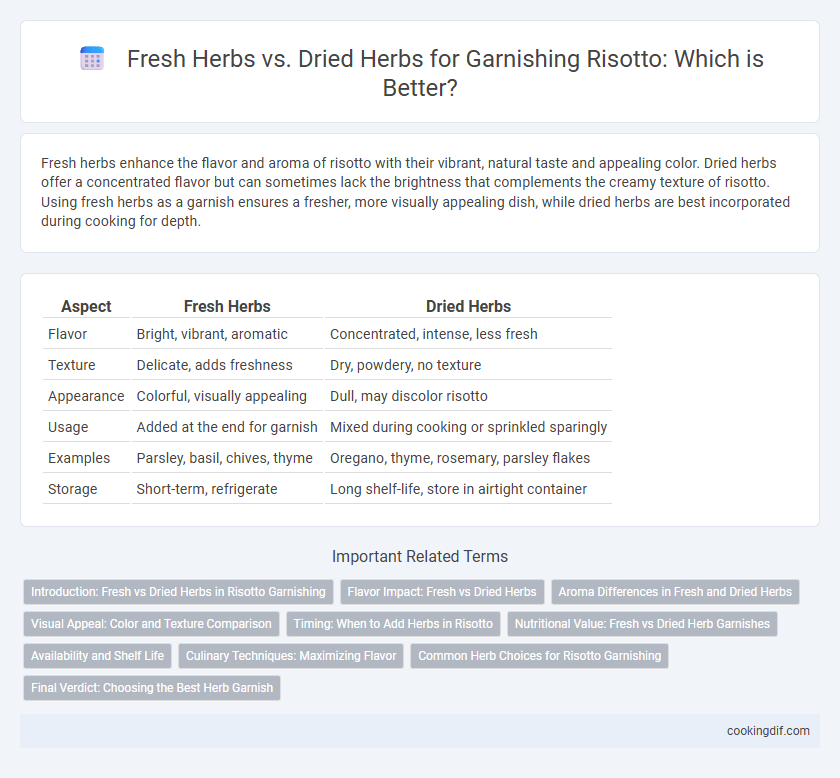Fresh herbs enhance the flavor and aroma of risotto with their vibrant, natural taste and appealing color. Dried herbs offer a concentrated flavor but can sometimes lack the brightness that complements the creamy texture of risotto. Using fresh herbs as a garnish ensures a fresher, more visually appealing dish, while dried herbs are best incorporated during cooking for depth.
Table of Comparison
| Aspect | Fresh Herbs | Dried Herbs |
|---|---|---|
| Flavor | Bright, vibrant, aromatic | Concentrated, intense, less fresh |
| Texture | Delicate, adds freshness | Dry, powdery, no texture |
| Appearance | Colorful, visually appealing | Dull, may discolor risotto |
| Usage | Added at the end for garnish | Mixed during cooking or sprinkled sparingly |
| Examples | Parsley, basil, chives, thyme | Oregano, thyme, rosemary, parsley flakes |
| Storage | Short-term, refrigerate | Long shelf-life, store in airtight container |
Introduction: Fresh vs Dried Herbs in Risotto Garnishing
Fresh herbs like parsley, basil, and thyme deliver vibrant aroma and bright flavor that enhance the creamy texture of risotto. Dried herbs, though concentrated in flavor, can overwhelm the delicate balance when used as a garnish and are best added earlier in cooking. Choosing fresh herbs for finishing risotto ensures a lively, fresh garnish that complements the dish's subtle richness.
Flavor Impact: Fresh vs Dried Herbs
Fresh herbs like basil, parsley, and chives provide a vibrant, aromatic flavor that enhances the creamy texture of risotto, while dried herbs offer a concentrated, earthy taste but can sometimes overpower the delicate balance. The volatile oils in fresh herbs release immediately upon garnishing, delivering a bright, lively finish, whereas dried herbs require longer cooking time to bloom and develop depth in the dish. Choosing fresh herbs as a garnish preserves the freshness and delicate herbal notes, making them ideal for risotto's subtle and nuanced flavor profile.
Aroma Differences in Fresh and Dried Herbs
Fresh herbs like basil, parsley, and thyme release vibrant, aromatic oils that enhance the risotto's flavor with bright, crisp notes. Dried herbs have a more concentrated, earthier aroma due to the drying process, but their intensity can sometimes overpower delicate dishes like risotto if used excessively. Using fresh herbs for garnishing maximizes freshness and complexity, while dried herbs provide a deeper, subtler fragrance best added early in cooking.
Visual Appeal: Color and Texture Comparison
Fresh herbs like basil, parsley, and chives provide vibrant green hues and a delicate texture that enhance the visual appeal of risotto, offering a fresh, crisp contrast to the creamy rice. Dried herbs tend to lose their color intensity and texture, often appearing dull and powdery, which can make the risotto look less appetizing. Using fresh herbs as a garnish highlights the dish's freshness and adds a striking pop of color that elevates the overall presentation.
Timing: When to Add Herbs in Risotto
Fresh herbs are best added at the end of cooking risotto to preserve their aroma and vibrant flavor, while dried herbs require earlier incorporation during the simmering process to fully release their essential oils. Timing the addition of herbs directly impacts the dish's overall taste profile, as fresh herbs like parsley or basil provide a bright finish, whereas dried herbs such as thyme or oregano deepen the flavor during cooking. Understanding the optimal timing ensures the risotto is garnished with maximum herbaceous intensity and balanced seasoning.
Nutritional Value: Fresh vs Dried Herb Garnishes
Fresh herbs used as garnishes in risotto offer higher levels of vitamins, antioxidants, and essential oils compared to dried herbs, enhancing both flavor and nutritional benefits. Dried herbs retain concentrated flavor compounds but lose some heat-sensitive nutrients and have reduced antioxidant potency due to the drying process. Choosing fresh herbs like parsley, basil, or chives maximizes nutrient intake while providing vibrant color and aroma to the dish.
Availability and Shelf Life
Fresh herbs like parsley, basil, and chives provide vibrant flavor and bright color for risotto but have limited availability and a short shelf life of a few days to a week when stored properly. Dried herbs such as thyme or oregano are available year-round, offering extended shelf life up to several months to a year when kept in airtight containers away from light and heat. Choosing between fresh and dried herbs depends on balancing the desire for fresh taste with convenience and long-term storage needs.
Culinary Techniques: Maximizing Flavor
Fresh herbs like parsley, basil, and chives provide vibrant, aromatic notes that enhance risotto's creaminess and texture, as their delicate oils release flavor without overpowering the dish. Dried herbs, being more concentrated, should be used sparingly and typically infused early in the cooking process to allow their robust flavors to meld into the risotto base. Optimal culinary technique involves adding fresh herbs at the final stage to preserve their bright taste and visual appeal while utilizing dried herbs for a deeper, integrated flavor profile during simmering.
Common Herb Choices for Risotto Garnishing
Fresh herbs like parsley, basil, and chives are preferred for risotto garnishing due to their vibrant flavor and aromatic qualities that enhance the dish's creamy texture. Dried herbs such as thyme or oregano offer a more concentrated taste but lack the freshness that complements risotto's delicate flavors. Common herb choices balance freshness and intensity, with fresh parsley and chives most frequently used to provide bright, herbaceous notes.
Final Verdict: Choosing the Best Herb Garnish
Fresh herbs like parsley, basil, and chives offer vibrant flavors and aromas that elevate a risotto's creamy texture, while dried herbs tend to have a more concentrated but muted taste best suited for cooking rather than garnishing. For garnishing risotto, fresh herbs provide a visually appealing contrast and a burst of freshness that complements the dish's rich profile. Selecting fresh herbs as a garnish enhances both the sensory experience and presentation, making them the superior choice over dried alternatives.
Fresh herbs vs Dried herbs for garnishing Infographic

 cookingdif.com
cookingdif.com